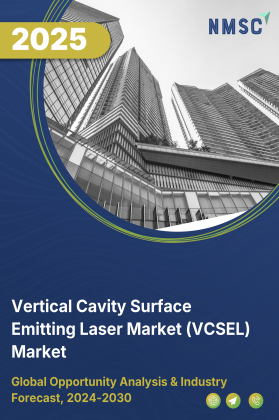
Vertical Cavity Surface Emitting Laser (VCSEL) Market by Material (Gallium Arsenide, Indium Phosphide, Gallium Nitride and Others), by Type (Single-mode VCSEL, Multi-mode VCSEL), by Wavelength (650–750 nm, 750–1400 nm, 1400–3000 nm), by Data Rate (Up to 10 Gbps, and Others), by Application (Sensing, Data Communication and Others), and by End-Use Industry (Consumer Electronics, Automotive, Healthcare and Others) – Global Opportunity Analysis and Industry Forecast, 2025–2030
Industry Outlook
The global Vertical Cavity Surface Emitting Laser (VCSEL) Market size was valued at USD 2.50 billion in 2024, with an estimation of USD 3.03 billion in 2025 and is predicted to reach USD 7.96 billion by 2030 with a CAGR of 21.3% from 2025-2030.
The VCSEL market is experiencing strong growth, driven by rising demand for high-speed data transmission, widespread adoption in consumer electronics, and increasing applications in the automotive industry. With the rapid expansion of cloud computing, 5G, and digital services, semiconductor lasers have become critical for fast, efficient data transfer in data centers. Their compact size, cost-effectiveness, and suitability for 3D sensing make them essential in smartphones, wearables, and AR/VR devices.
In the automotive sector, laser-based emitters support LiDAR, ADAS, and driver monitoring, fuelling further adoption. However, high production costs and manufacturing complexities pose challenges. Nonetheless, expanding AR/VR and 3D sensing applications present significant growth opportunities for the VCSEL sector.
High-Speed Data Demand Drives the Market Growth
With the explosive rise of cloud computing, video streaming, online gaming, artificial intelligence (AI), and the Internet of Things (IoT), the global volume of digital data is increasing at an unprecedented rate. This surge requires faster and more efficient data transfer solutions within data centers and telecommunication networks. LiDAR technology is an ideal choice because they offer high modulation speeds, low power consumption, and cost-effective manufacturing compared to traditional lasers. Their ability to support short-reach optical interconnects makes them crucial in data centers, where minimizing latency and maximizing bandwidth are top priorities. As digital services expand and 5G networks roll out, the demand for semiconductor laser technology in high-speed optical communication continues to accelerate, driving significant growth in the industry.
Widespread Adoption of Consumer Electronics and Gadgets Boost the Market Demand
Modern consumer electronics increasingly rely on advanced sensing technologies for enhanced user experiences. VCSELs play a key role in 3D sensing applications such as facial recognition, gesture control, augmented/virtual reality (AR/VR), and proximity detection. Their compact size, low cost, and ability to form dense arrays make them well-suited for integration into slim devices like smartphones, tablets, wearables, and gaming systems. As manufacturers continue to push for smarter, more interactive, and secure devices, the demand for compact semiconductor lasers in consumer electronics is growing rapidly. This widespread adoption in everyday gadgets significantly drives the overall VCSEL market growth forward.
Rise in Automotive Industry Fuels Market Expansion
The automotive industry is rapidly adopting VCSEL technology for LiDAR systems, driver monitoring, and Advanced Driver Assistance Systems (ADAS). These semiconductor lasers provide precise depth sensing and high reliability, making them essential for applications like collision avoidance, parking assistance, blind-spot detection, and autonomous driving. Their small size, energy efficiency, and cost-effectiveness make them suitable for integration into vehicles, where multiple sensors are required. As automakers push towards higher levels of vehicle automation and enhanced safety features, the use of laser-based emitters in automotive sensing is expanding, creating strong growth opportunities for the VCSEL industry.
High Initial Investment and Manufacturing Complexity Limits the Market Growth
Although compact semiconductor lasers are cost-effective at scale, their design, fabrication, and testing require advanced equipment and specialized expertise. The production process involves high precision in epitaxial growth and wafer-level testing, which lead to significant upfront costs for manufacturers. Smaller companies and new entrants find it challenging to compete with established players that already have the infrastructure and resources. This high barrier to entry and the complexity of scaling production act as a restraint on the widespread adoption of VCSEL market expansion.
Expansion in 3D Sensing and AR/VR Applications Creates New Growth Opportunities
The growing adoption of augmented reality (AR), virtual reality (VR), and mixed reality (MR) in consumer electronics, gaming, and industrial training creates a major growth opportunity for VCSEL market. These lasers enable accurate depth sensing, gesture recognition, and eye/hand tracking, which are essential for immersive experiences. As demand for next-generation smartphones, wearable devices, and AR/VR headsets continues to rise, VCSELs are positioned to play a critical role, opening up new revenue streams for manufacturers beyond traditional data communication uses.
Market Segmentations and Scope of the Study
The vertical cavity surface emitting laser (VCSEL) market report is segmented on the basis of material, type, wavelength, data rate, application, end-use industry and region. On the basis of material, the market is divided into Gallium Arsenide, Indium Phosphide, Gallium Nitride, and others. By type, the market is categorized into single-mode VCSEL and multi-mode VCSEL. On the basis of wavelength, the market is segmented into 650 to 750nnm, 750 to 1400 nm, and 1400 to 3000 nm, while based on data rate, it includes up to 10 gbps, 10.1 to 25 gbps, and above 25 gbps. On the basis of end-use industry, the market is segmented into consumer electronics, automotive, healthcare, industrial, aerospace and defense, and others. The regional breakdown includes regions such as North America, Europe, Asia-Pacific, and the Rest of the World (RoW).
Geographical Analysis
The automotive sector is a vital contributor to the U.S. economy, generating about USD 1.2 trillion annually, or 4.8% of GDP, according to the Alliance for Automotive Innovation in 2025. This strong ecosystem is accelerating the integration of advanced technologies such as LiDAR, ADAS, and driver monitoring systems, where VCSELs play a crucial role by enabling precise depth sensing and reliable performance.
As automakers and tech companies in North America continue investing heavily in autonomous and semi-autonomous vehicles, the demand for VCSEL-based sensing solutions is expected to grow, making automotive innovation a key driver of the VCSEL market share.
Europe is witnessing strong growth in cloud computing, digitalization, and 5G network rollouts, driven by increasing demand for high-speed connectivity across industries and consumers. Countries like Germany, the UK, and the Nordics are investing heavily in new data centers and telecom infrastructure, supported by EU digital transformation initiatives.
VCSELs are widely used in short-reach optical interconnects within data centers and in high-speed optical communication for 5G, thanks to their low power consumption, high modulation speed, and cost-effectiveness. This surge in digital infrastructure investment makes data center and 5G expansion a major driver of VCSEL adoption in the European market.
Asia-Pacific dominates global smartphone and electronics manufacturing, with countries like China, South Korea, Japan, and India driving massive demand for advanced devices. According to India Brand Equity Foundation (IBEF) in 2024, India accounted for 15.5% of global smartphone shipments, second only to China at 22%, highlighting the region’s strength in consumer electronics.
This growth is fueling the integration of 3D sensing application, facial recognition, AR/VR, and proximity detection across smartphones, wearables, and other gadgets. With both strong manufacturing capabilities and a rapidly expanding consumer base, Asia-Pacific remains a critical driver of VCSEL market demand through its booming electronics ecosystem.
Countries in the Middle East, Africa, and Latin America are steadily adopting advanced medical technologies. VCSELs are being integrated into biomedical imaging, diagnostics, and wearable health monitoring devices due to their compact size, low power use, and precise wavelength control. Rising investments in modern healthcare infrastructure, along with increasing demand for portable and home-based medical devices, are driving VCSEL adoption in these regions. As governments and private players in the Rest of the World (RoW) continue to prioritize digital healthcare and telemedicine, VCSEL-based solutions are expected to play a significant role in supporting this transition.
Strategic Innovations Adopted by Key Players
Key players in the VCSEL industry are accelerating innovation and market leadership through next-gen product launches, advanced chip integration, and scaling production capacity.
-
In July 2025, Lumentum and Coherent are scaling up production of Chip-on-Submount (COS) packaged VCSEL arrays to meet rising demand from Apple Vision Pro and next-gen LiDAR applications.
-
In March 2025, Broadcom unveiled new ultra-efficient AI networking chips (Sian3 and Sian2M). Notably, Sian2M integrates VCSEL drivers and 200 G VCSELs for power-optimal, short-reach links.
-
In March 2024, Broadcom demonstrated the industry’s first 200 Gbps-per-lane VCSEL, alongside 200 G/lane EMLs and CW lasers, reinforcing its leadership in high-speed optical interconnects for AI and ML systems.
Key Benefits
-
The report provides quantitative analysis and estimations of the industry from 2025 to 2030, which assists in identifying the prevailing VCSEL market opportunities.
-
The study comprises a deep-dive analysis of the current and future VCSEL market trends to depict prevalent investment pockets in the sector.
-
Information related to key drivers, restraints, and opportunities and their impact on the market is provided in the report.
-
Competitive analysis of the players, along with their market share is provided in the report.
-
SWOT analysis and Porters Five Forces model is elaborated in the study.
-
Value chain analysis in the market study provides a clear picture of roles of stakeholders
VCSEL Market Key Segments
By Material
-
Gallium Arsenide
-
Indium Phosphide
-
Gallium Nitride
-
Others
By Type
-
Single-mode VCSEL
-
Multi-mode VCSEL
By Wavelength
-
650–750 nm
-
750–1400 nm
-
1400–3000 nm
By Data Rate
-
Up to 10 Gbps
-
10.1 to 25 Gbps
-
Above 25 Gbps
By Application
-
Sensing
-
3D Sensing
-
Gesture Recognition
-
Facial Recognition
-
LiDAR
-
Industrial Sensing
-
-
Data Communication
-
Optical Interconnects
-
Data Centers
-
Telecom Infrastructure
-
-
Illumination
-
Laser Printing
-
Industrial Heating
-
-
Others
By End Use Industry
-
Consumer Electronics
-
Automotive
-
Healthcare
-
Industrial
-
Aerospace & Defense
-
Others
By Region
-
North America
-
The U.S.
-
Canada
-
Mexico
-
-
Europe
-
The UK
-
Germany
-
France
-
Italy
-
Spain
-
Denmark
-
Netherlands
-
Finland
-
Sweden
-
Norway
-
Russia
-
Rest of Europe
-
-
Asia-Pacific
-
China
-
Japan
-
India
-
South Korea
-
Australia
-
Indonesia
-
Singapore
-
Taiwan
-
Thailand
-
Rest of Asia-Pacific
-
-
RoW
-
Latin America
-
Middle East
-
Africa
-
Key Players
-
Broadcom Inc.
-
TRUMPF Group
-
ams OSRAM AG
-
Vertilas GmbH
-
Sumitomo Electric Industries, Ltd.
-
IQE plc
-
Santec Corporation
-
Hamamatsu Photonics K.K.
-
Panasonic Corporation
-
Sony Corporation (Sony Semiconductor Solutions Corp.)
-
Excelitas Technologies Corp.
-
RayCan Co., Ltd.
-
Vertilite Co. Ltd.
Report Scope and Segmentation:
|
Parameters |
Details |
|
Market Size in 2025 |
USD 3.03 Billion |
|
Revenue Forecast in 2030 |
USD 7.96 Billion |
|
Growth Rate |
CAGR of 21.3% from 2025 to 2030 |
|
Analysis Period |
2024–2030 |
|
Base Year Considered |
2024 |
|
Forecast Period |
2025–2030 |
|
Market Size Estimation |
Billion (USD) |
|
Growth Factors |
|
|
Countries Covered |
28 |
|
Companies Profiled |
15 |
|
Market Share |
Available for 10 companies |
|
Customization Scope |
Free customization (equivalent up to 80 working hours of analysts) after purchase. Addition or alteration to country, regional, and segment scope. |
|
Pricing and Purchase Options |
Avail customized purchase options to meet your exact research needs. |

















 Speak to Our Analyst
Speak to Our Analyst

























